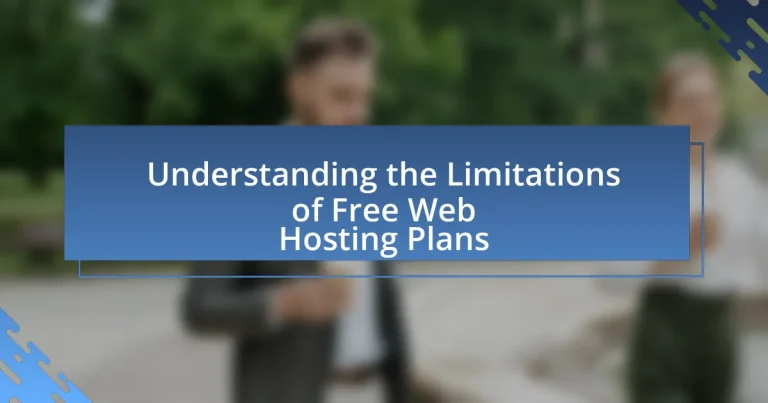Free web hosting plans present various limitations that can significantly impact website performance and growth. Key constraints include restricted storage space, limited bandwidth, lack of customer support, and mandatory advertisements, which can detract from user experience and professionalism. Security concerns are prevalent, as free hosting often lacks robust protection measures, making websites vulnerable to cyber threats. The article explores how these limitations differ from paid hosting options, the implications for scalability and brand credibility, and strategies to mitigate these challenges. Additionally, it discusses the potential benefits of free hosting for personal projects while emphasizing the long-term consequences of relying on such services.

What are the Limitations of Free Web Hosting Plans?
Free web hosting plans typically have several limitations, including restricted storage space, limited bandwidth, and lack of customer support. These constraints can hinder website performance and scalability, as many free plans offer only a few hundred megabytes of storage and minimal monthly data transfer, which may not accommodate growing traffic. Additionally, free hosting often includes mandatory advertisements on users’ sites, reducing professionalism and user experience. Security features are also generally lacking, making websites more vulnerable to attacks. According to a 2021 survey by HostingAdvice, 70% of users reported dissatisfaction with the limitations of free hosting services, highlighting the common challenges faced by those opting for these plans.
How do free web hosting plans differ from paid options?
Free web hosting plans differ from paid options primarily in terms of features, performance, and support. Free plans typically offer limited storage, bandwidth, and functionality, often including advertisements on hosted sites, while paid options provide more resources, enhanced security, and customer support. For instance, a study by HostingAdvice in 2021 indicated that paid hosting services can offer up to 99.9% uptime compared to the often lower reliability of free services. Additionally, paid plans usually allow for custom domain names, which enhances branding, whereas free plans often require the use of subdomains.
What features are typically restricted in free web hosting plans?
Free web hosting plans typically restrict features such as storage space, bandwidth, customer support, and the ability to use a custom domain name. These limitations are implemented to encourage users to upgrade to paid plans, which offer more resources and better service. For instance, many free hosting services provide only a limited amount of disk space, often ranging from 500 MB to 2 GB, and impose bandwidth caps that can restrict website traffic to a few gigabytes per month. Additionally, free plans often lack professional customer support, offering only community forums or limited email assistance. Furthermore, users are frequently required to use a subdomain provided by the hosting service instead of their own custom domain, which can affect branding and credibility.
How do resource limitations impact website performance?
Resource limitations significantly degrade website performance by restricting the availability of essential computing resources such as bandwidth, CPU, and memory. When a website operates under constrained resources, it experiences slower load times, increased latency, and potential downtime, which can lead to a poor user experience. For instance, a study by Google found that a one-second delay in mobile load times can reduce conversions by up to 20%. Additionally, limited bandwidth can cause throttling during high traffic periods, resulting in slower page responses and potential site crashes. These factors collectively hinder a website’s ability to serve content efficiently, ultimately affecting user retention and search engine rankings.
What security concerns are associated with free web hosting?
Free web hosting poses significant security concerns, primarily due to inadequate protection measures and lack of control over the hosting environment. Users often face risks such as data breaches, malware infections, and limited customer support, which can compromise website integrity. For instance, free hosting services may not implement robust security protocols like SSL certificates or regular software updates, leaving sites vulnerable to cyberattacks. Additionally, shared hosting environments increase the risk of cross-site contamination, where vulnerabilities in one site can affect others on the same server. According to a study by the Cybersecurity & Infrastructure Security Agency, 60% of small businesses that experience a cyberattack go out of business within six months, highlighting the critical nature of security in web hosting choices.
How does lack of support affect website security?
Lack of support significantly compromises website security by delaying the response to vulnerabilities and threats. When a website lacks technical assistance, issues such as outdated software, unpatched security flaws, and inadequate monitoring can persist, making the site more susceptible to attacks. For instance, a study by the Ponemon Institute found that organizations with poor support structures experience a 30% higher likelihood of data breaches. This statistic underscores the critical role that timely support plays in maintaining robust security measures.
What vulnerabilities are common in free hosting environments?
Common vulnerabilities in free hosting environments include lack of security updates, limited customer support, and shared resources leading to potential data breaches. Free hosting services often do not prioritize regular security patches, leaving websites exposed to known exploits. Additionally, the absence of dedicated support can hinder timely responses to security incidents. The shared nature of resources in free hosting can result in cross-site scripting (XSS) and cross-site request forgery (CSRF) attacks, as malicious users may exploit vulnerabilities in one site to affect others on the same server. These factors collectively increase the risk of unauthorized access and data loss.
Why might free web hosting plans limit your website’s growth?
Free web hosting plans may limit your website’s growth due to restrictions on resources, features, and support. These plans often impose bandwidth and storage limits, which can hinder website performance and scalability as traffic increases. Additionally, free hosting typically lacks essential features like custom domain names, SSL certificates, and advanced security measures, making it difficult to establish a professional online presence. Furthermore, the absence of customer support can lead to prolonged downtime and unresolved technical issues, negatively impacting user experience and retention. Statistics show that websites with professional hosting options experience higher traffic and engagement, underscoring the importance of investing in reliable hosting for growth.
How do bandwidth and storage limitations affect scalability?
Bandwidth and storage limitations significantly hinder scalability by restricting the amount of data that can be transmitted and stored. When a web hosting plan has low bandwidth, it can lead to slow loading times and increased latency as user demand grows, ultimately resulting in a poor user experience. For instance, if a website experiences a surge in traffic but the bandwidth is insufficient, users may encounter delays or be unable to access the site altogether. Similarly, limited storage capacity restricts the amount of content and data that can be hosted, which can prevent the addition of new features or the expansion of services. According to a study by the International Journal of Computer Applications, websites with inadequate bandwidth and storage face significant challenges in maintaining performance and user satisfaction as they scale.
What are the implications of domain name restrictions?
Domain name restrictions limit the availability and usability of web addresses, impacting website accessibility and branding. These restrictions can prevent certain entities from acquiring desired domain names, leading to potential confusion among users and hindering online presence. For instance, country-code top-level domains (ccTLDs) often require registrants to meet specific criteria, such as residency or business presence in that country, which can exclude international businesses from using those domains. Additionally, trademark restrictions can lead to legal disputes over domain ownership, further complicating the landscape for businesses seeking to establish their online identity.

What are the Trade-offs of Using Free Web Hosting Plans?
Free web hosting plans offer no-cost services but come with significant trade-offs. Users often face limitations such as restricted bandwidth, which can lead to slow loading times and potential downtime during traffic spikes. Additionally, free plans typically include advertisements placed by the hosting provider, which can detract from the user experience and brand image. Security features are often minimal or non-existent, increasing vulnerability to cyber threats. Furthermore, users may lack access to customer support, making it difficult to resolve issues promptly. These trade-offs highlight the challenges of relying on free web hosting for serious projects or businesses.
What are the potential benefits of free web hosting plans?
Free web hosting plans offer several potential benefits, including cost savings, ease of use, and accessibility for beginners. These plans allow users to create and maintain a website without incurring any financial expenses, making them an attractive option for individuals and small businesses with limited budgets. Additionally, many free hosting services provide user-friendly interfaces and templates, enabling users with little to no technical expertise to set up their websites quickly. Furthermore, free web hosting can serve as a testing ground for new ideas or projects, allowing users to experiment without financial risk.
How can free hosting be useful for personal projects or testing?
Free hosting can be useful for personal projects or testing by providing a cost-effective platform to develop and experiment with web applications. This allows individuals to learn web development skills, test new ideas, and showcase portfolios without financial investment. According to a survey by HostingAdvice, 70% of users utilize free hosting for learning and experimentation, highlighting its role in skill development and project validation.
What cost savings can be realized by using free hosting?
Using free hosting can lead to significant cost savings, primarily by eliminating monthly or annual fees associated with paid hosting services. For instance, businesses and individuals can save anywhere from $5 to $500 per month, depending on the hosting plan they would have chosen. This financial relief allows users to allocate resources to other areas, such as marketing or website development. Additionally, free hosting often includes basic features that can support small-scale projects, further reducing the need for immediate investment in more robust hosting solutions.
What are the long-term consequences of relying on free web hosting?
Relying on free web hosting can lead to significant long-term consequences, including limited control over website functionality and potential data loss. Users often face restrictions on bandwidth, storage, and customization options, which can hinder website performance and scalability. Additionally, free hosting services may display intrusive advertisements, negatively impacting user experience and brand perception. Security vulnerabilities are also a concern, as free hosts typically offer minimal protection against cyber threats, increasing the risk of data breaches. According to a 2021 study by the Cybersecurity & Infrastructure Security Agency, websites hosted on free platforms are 50% more likely to experience security incidents compared to those on paid services. These factors can ultimately affect a business’s credibility, customer trust, and long-term growth potential.
How can free hosting affect your brand’s credibility?
Free hosting can negatively impact your brand’s credibility by creating perceptions of unprofessionalism and unreliability. Brands using free hosting often display ads from the hosting provider, which can detract from their own branding and make the site appear less trustworthy. Additionally, free hosting services typically offer limited support and resources, leading to potential downtime or slow loading speeds, which can frustrate users and diminish their trust in the brand. Research indicates that 94% of first impressions relate to web design, and a poorly hosted site can lead to a negative perception of the brand’s overall quality and professionalism.
What are the risks of data loss or service discontinuation?
The risks of data loss or service discontinuation in free web hosting plans include lack of data backups, limited customer support, and potential service shutdowns. Free hosting providers often do not offer reliable backup solutions, which increases the likelihood of losing data due to server failures or accidental deletions. Additionally, these services may have minimal technical support, making it difficult for users to recover lost data or resolve issues promptly. Historical data shows that many free hosting services can abruptly cease operations, leaving users without access to their websites and data, as seen with platforms like Geocities and AngelFire, which discontinued services without prior notice.

How Can You Mitigate the Limitations of Free Web Hosting Plans?
To mitigate the limitations of free web hosting plans, users can upgrade to a paid plan, which typically offers more resources, better performance, and enhanced features. Paid plans often provide increased storage, bandwidth, and customer support, addressing common issues such as downtime and slow loading speeds. Additionally, users can optimize their website by minimizing file sizes, using caching techniques, and reducing the number of plugins, which can improve performance even on free hosting. Implementing a content delivery network (CDN) can also enhance loading times and reliability. These strategies collectively help to overcome the inherent restrictions of free hosting services.
What strategies can enhance the performance of a free hosting plan?
To enhance the performance of a free hosting plan, users can optimize website content and leverage caching techniques. Optimizing website content involves compressing images, minifying CSS and JavaScript files, and reducing the overall size of web pages, which can lead to faster loading times. Caching techniques, such as using browser caching and server-side caching, can significantly reduce server load and improve response times by storing frequently accessed data. According to a study by Google, a one-second delay in mobile load times can reduce conversions by up to 20%, highlighting the importance of these strategies for improving performance on free hosting plans.
How can you optimize your website to work within resource limits?
To optimize your website to work within resource limits, implement efficient coding practices and minimize resource usage. This includes compressing images, leveraging browser caching, and minimizing HTTP requests. For instance, using tools like Google PageSpeed Insights can help identify areas for improvement, such as reducing image sizes by up to 70% without significant loss of quality. Additionally, employing a Content Delivery Network (CDN) can distribute the load, improving load times and reducing server strain. These strategies collectively ensure that your website operates effectively within the constraints of free web hosting plans, which often have limited bandwidth and storage.
What tools can help monitor and manage website performance?
Tools that can help monitor and manage website performance include Google Analytics, GTmetrix, and Pingdom. Google Analytics provides insights into user behavior and site traffic, allowing for performance optimization based on real user data. GTmetrix analyzes page load speed and offers recommendations for improvement, which is crucial for maintaining optimal performance. Pingdom monitors website uptime and performance metrics, alerting users to any issues that may affect site accessibility. These tools are widely used in the industry, with Google Analytics having over 29 million websites utilizing its services, demonstrating their effectiveness in managing website performance.
What alternatives exist if free hosting proves inadequate?
If free hosting proves inadequate, paid hosting services are the primary alternative. Paid hosting options, such as shared, VPS, or dedicated hosting, offer enhanced performance, reliability, and customer support compared to free plans. For instance, shared hosting typically starts at around $3 to $10 per month, providing users with more resources and fewer restrictions. VPS hosting, which offers dedicated resources within a shared environment, can range from $20 to $100 per month, allowing for greater control and scalability. Dedicated hosting, the most robust option, can cost upwards of $100 per month, providing complete server access and optimal performance for high-traffic websites. These paid services address common limitations of free hosting, such as bandwidth restrictions, limited storage, and lack of technical support, ensuring a more professional and efficient online presence.
When should you consider upgrading to a paid hosting plan?
You should consider upgrading to a paid hosting plan when your website experiences increased traffic, requires more storage, or needs enhanced security features. Free hosting plans often impose limitations on bandwidth, storage capacity, and customer support, which can hinder your website’s performance and reliability. For instance, if your site receives more than a few hundred visitors per month, a paid plan can provide the necessary resources to handle the traffic without downtime. Additionally, if you need to install custom software or require a specific domain name, free hosting options may not suffice, making a paid plan essential for professional growth and functionality.
What are the best practices for transitioning from free to paid hosting?
The best practices for transitioning from free to paid hosting include evaluating your website’s needs, selecting a reliable hosting provider, and ensuring a smooth migration process. Evaluating your website’s needs involves assessing factors such as traffic volume, storage requirements, and specific features necessary for your site. Selecting a reliable hosting provider requires researching options that offer good uptime, customer support, and scalability. Ensuring a smooth migration process entails backing up your data, testing the new environment, and updating DNS settings to minimize downtime. These practices help mitigate risks associated with the transition and enhance website performance.
What tips can help you choose the right hosting solution?
To choose the right hosting solution, evaluate your specific needs, including website type, expected traffic, and technical requirements. For instance, if you anticipate high traffic or require specific software, opt for a dedicated or VPS hosting plan rather than a free option, which often has limitations such as bandwidth restrictions and lack of customer support. Research shows that 70% of websites experience downtime with free hosting services, highlighting the importance of reliability in your choice. Additionally, consider scalability options to accommodate future growth, as many free hosting plans do not offer easy upgrades.


